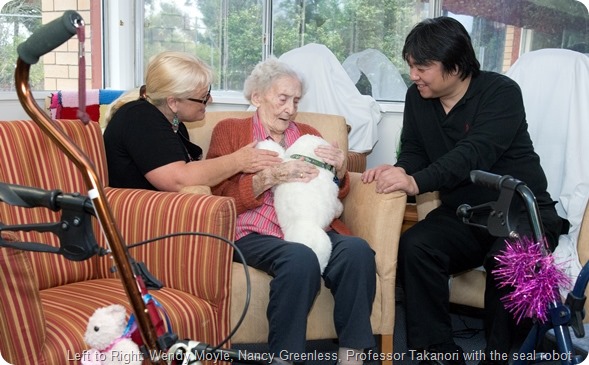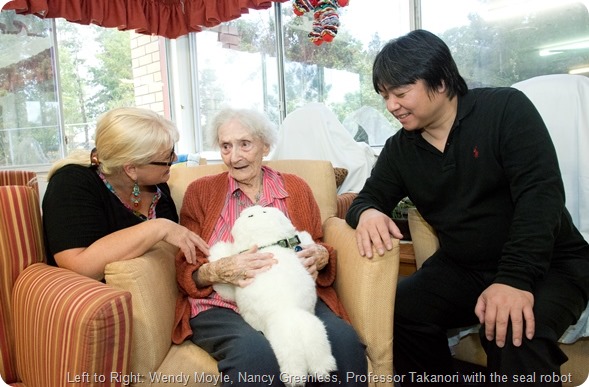Animal robots for dementia treatment: an interview with Professor Wendy Moyle, Griffith University
Interview conducted by April Cashin-Garbutt, BA Hons (Cantab) published on April 5, 2013
Where did the idea of using animal robots in the treatment of dementia originate?
A robotic cat was first trialled in the US in early 2004 as a companion pet for people with dementia. A number of nursing homes have either ‘toy’ or robotic animals that they use as entertainment for older residents as well as people with dementia.
Although readily available for use there has been limited research conducted on using animal robots and in particular in using them in a therapeutic or emotional way with people living with dementia. Furthermore, previous studies such as those conducted by the developer of Paro have been limited by sample as well as design limitations.
What advantages do robotic animals have over traditional ‘toy’ animals?
This is something that we are also interested in as to date the research has not looked at a comparison between ‘toy’ (non-robotic) animals and robotic animals. However, our preliminary research has found that the robotic features of Paro assist the person with dementia to engage.

Professor Takanori is in Australia from Japan to meet with Professor Wendy Moyle to talk about the robots for dementia
For example, when Paro turns when called and responds positively to touch we also observe the person with dementia connecting with the robot to encourage the Paro to respond with them again.
Why do you think there has been limited research on using animal robots in a therapeutic way?
It appears that some members of society are not keen to see robots used in health and social care and this has probably had an influence on opportunities, including access to funds to research their use.
For example, when first seeking funds for our research we were challenged by several health professionals who expressed fears that they felt we were trying to replace the role of the carer with robots. This was in spite of our reports and protocol that demonstrated the robot was to be used as an adjunct to the carer role.
Also until people see the robotic features of some of our robotic animals they imagine that they are stuffed toys and they express concerns about giving toys to older people.
This type of research requires considerable funds to fund not only the purchase of the Paro but also the research trial. So naturally when funds are not available this will reduce the number of trials conducted.
Please can you give a brief introduction to “Paro” the robotic seal?
Paro was developed by Takanori Shibata, a researcher at Japan’s National Institute of Advanced Industrial Science and Technology. Paro is a therapeutic, pet-type robot with the appearance of a baby harp seal.
Paro has tactile sensors and moves its tail and flippers and will respond by opening its eyes and moving its face toward the sound of voice. Paro’s sensors monitor sound, light, temperature and touch and Paro respond’s appropriately, such as responding to its name and being stroked.
Paro can show various emotions including surprise, happiness and anger, and Paro will cry if it is not receiving sufficient attention.
Why was a seal developed over a more traditional pet such as a dog or cat?
Some people have a fear of cats or dogs for example, whereas Paro is a neutral animal, and certainly not one that people tend to have fears of. The Paro shape and size is approximately the size of a new-born baby so we find this also allows the individual to hold Paro and to place Paro on their shoulder or lap just as they would with a new born baby.
To date we find that the people involved in our research tend to look at Paro with surprise and seek to understand what it is. We have not had anyone who has been fearful of Paro. When using robotic animals in a group situation we find some people will prefer a cat but to date we have not compared reactions to our assortment of robotic animals.
What symptoms of dementia does Paro treat?
Our preliminary research has shown that Paro stimulates and engages people with dementia, and with some individuals this has helped them to communicate their emotions. Furthermore, we have found that Paro reduces anxiety, and improves mood states.
How do you think Paro produces these effects?
Paro engages an emotional response as it reacts to people responding to it. For example, it will respond when called and react peacefully when an individual shows it attention. Stroking Paro can be soothing but the feature that seems to draw people to Paro is its eyes; it blinks its long eyelashes and looks directly into the face of the person who has spoken to it.

However, it is not only people with dementia who find Paro induces a relaxing response. For example, I have been in situations in my university and at conferences where academics will pick up the Paro and talk with it as though it is a human form. Even as adults we enjoy play and Paro offers this opportunity in a comforting way.
How do you plan to evaluate Paro’s benefits?
We plan to build on our research with a larger sample of participants and to consider the effect of the robotic features, and contribution of the robot to communication and social interaction.
Our research will use a mixed method approach that will capture the effects using both quantitative outcomes, and qualitative observations and interviews.
Pages: 1 2







